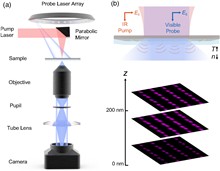 View fulltext
View fulltext
The commentary discusses a recent report of metasurface-enhanced infrared photothermal (MEIP) microscopy, which simultaneously overcomes long-standing sensitivity and spatial resolution barriers in midinfrared spectroscopy, advancing detection sensitivity to the nanomolar level.
The authors comment on a recent significant advancement in developing a chiral sensor that is both sensitive and robust.
The commentary discusses recently published design for antireflective coating on solar cells. The proposed free-form inverse design, based on single-layer silicon metasurfaces, dramatically suppresses broadband optical reflection from silicon surfaces.
Advanced Photonics associate editor Dr. Jennifer Dionne interviewed Dr. Harry Atwater, Otis Booth Leadership Chair of the Division of Engineering and Applied Science at Caltech, Howard Hughes Professor of Applied Physics and Material Science, and director of the Liquid Sunlight Alliance.
Low-Earth orbit, the primary operational domain for the international space station and commercial satellites, presents a severe thermodynamic environment for spacecraft. Current testing methodologies, such as thermal cycling and damp-heat assessments, are inadequately aligned with the characteristics of perovskites. The commentary suggests a tiered thermal stress testing framework to enhance existing standards and support a robust and standardized framework for certification.
Laser excitation of nanoparticles can excite vibrational modes of the particles that correspond to changes in size and shape. The frequencies and lifetimes of these modes provide information about the mechanical properties of the particles, and how they interact with their environment. Studies of these modes in virus particles can thus provide unique information about viruses, and how their properties change during their lifecycle.
Ultrafast lasers can produce, beyond single-pulse mode locking, a multitude of robust multi-pulse dynamics, including optical soliton molecules. Based on recent experimental advances using smart fiber lasers, this commentary addresses the open question of using soliton molecules as symbols for digital optical information.
X-ray free-electron lasers (XFELs) have revolutionized ultrafast science with exceptional spatiotemporal resolution, yet attosecond-level beam diagnostics face critical challenges. The article comments on PolariX TDS, a polarization-tunable X-band deflector developed by CERN, DESY, and PSI, which overcomes these limits by enabling multidimensional phase-space characterization with sub-femtosecond resolution.
The article comments on a significant breakthrough in detecting mid-infrared light at low photon counts.
The emerging discipline of picophotonics explores events on a scale thousands of times smaller than the wavelength of light. A recent work introduces a phase singularity ruler that allows picometer-scale localization metrology in three dimensions.
The commentary discusses work recently published in Physical Review Letters, which reported a nondestructive approach to realizing precise control of p-p stacking at single molecule scale by laser illumination.
Prof. Philip Russell (Max Planck Institute for the Science of Light) discusses the development of photonic crystal fibers, in a conversation with Prof. Long Zhang (Chinese Academy of Sciences).
Label-free vibrational stimulated Raman microscopy surpasses the diffraction limit by employing structured illumination, opening new avenues for super-resolution imaging of biological targets.
The commentary examines a recent advancement in quantum simulations.
The application of light remains constrained in deep tissues, where we struggle to achieve the same or comparable high-resolution focusing and imaging as in superficial tissues. This limitation mainly arises from the spatial inhomogeneities of refractive index (RI) in biological tissues, where light propagation is severely hindered by scattering and absorption. In recent years, enhancing imaging outcomes by reducing the scattering effects in tissues has become a hot topic of research. One effective way is to increase the refractive index of the aqueous components with optical clearing agents, achieving an effective RI level closer to that of lipids and proteins. This article comments on a recent study that reported a counterintuitive yet plain approach to the barrier and achieved biocompatible transparency of live tissues. In brief, the proposed strategy enables harmless, reversible tissue clarification of living rodents, greatly increasing the penetration depth and resolution of current in-vivo imaging technologies.
In celebration of the 60th anniversary of the founding of the Shanghai Institute of Optics and Fine Mechanics, the institute launched a public call for questions and challenges in laser science and technology. Twenty questions were ultimately selected, covering the mechanisms of coherent light sources, laser applications in imaging and manufacturing, new laser materials, and so on. These questions may serve as guidance in the future development of laser physics and applications.
The 2024 Nobel Prize in Physics recognized John Hopfield and Geoffrey Hinton for their pioneering work on artificial neural networks, which profoundly impacted the physical sciences, particularly optics and photonics. This perspective summarizes the Nobel laureates’ contributions, highlighting the physics-based principles and inspiration behind the development of modern artificial intelligence (AI) and also outlining some of the emerging major advances achieved in optics and photonics enabled by AI.
Demetri Psaltis (École Polytechnique Fédérale de Lausanne) discusses advances in optical computing, in conversation with Guohai Situ (Shanghai Institute of Optics and Fine Mechanics, Chinese Academy of Sciences), for the Advanced Photonics theme issue on AI and Photonics.
The article comments on a recently developed neural network that enables ultrathin flat optics imaging in full color.
The article comments on a novel device recently reported in Nature, which combines a dielectric bowtie nanoantenna with a twisted lattice nanocavity to achieve sub-diffraction-limited mode volumes.
Vectorial states of light, where the polarization is inhomogeneously distributed in space, have gained considerable interest in the context of structured light, but their inherent parity has hitherto been overlooked. Now, parity has been revealed as a fundamental degree of freedom in vectorial light that can be acted on with customized metasurfaces, opening a path to high capacity classical and quantum communication.
The article comments on a recent advance in large-scale distributed diffractive-interference hybrid photonic chiplet Taichi for artificial general intelligence applications.
Prof. Jelena Vučković (Stanford University) discusses her research and inspirations, in conversation with Advanced Photonics Early Career Editorial Board Member Prof. Menjie Yu (University of Southern California).
The substantial and unstable dark current in metal halide perovskite photodetectors hampers their continued advancement. To address this issue, an innovative architecture has been proposed to effectively overcome the challenge of dark current in perovskite photoconductor-type devices, resulting in an almost negligible dark current and an exceptionally low dark current drift.
Prof. Em. Joseph Braat reviews the development of optical storage and lithography in the Netherlands, and his transition to academia.
The editorial introduces JMI Issue 3 Volume 11, looks ahead to SPIE Medical Imaging, and highlights the journal’s policy on conference article submission.
Despite the significant advancements in perovskite light-emitting diodes (PeLEDs), achieving high-performance blue LEDs remains a key concern for future display and optical communication applications, particularly pure-blue PeLEDs with high external quantum efficiency (EQE) and luminance. Recently, Hou and colleagues reported the utilization of an efficient additive that enables stable emission color with an enhanced EQE of 9.25% and a maximum luminance of 1806 cd cm-2, representing one of the best-performing pure-blue PeLEDs.
The article comments on a recent framework for all-optical classification using orbital-angular-momentum-encoded diffractive networks.
The article comments on recent work that provides theoretical underpinnings and experimental verification for modal power coupling in an air-core fiber, considering various types of modes.
Serge Haroche shares perspectives from his illustrious scientific career in physics and the evolving field of quantum photonics, in conversation with Chao-Yang Lu.
The Nobel Prize in Physics 2023 was awarded to Pierre Agostini, Ferenc Krausz and Anne L’Huillier for “experimental methods that generate attosecond pulses of light for the study of electron dynamics in matter.” We review the history of attosecond physics, recount the laureates’ achievements and their place within the field, discuss the breakthroughs made possible by the creation of attosecond pulses, and look to the future advances in attoscience.
Professor Guoqing Chang (Chinese Academy of Sciences) interviewed Professor Din Ping Tsai (City University of Hong Kong) on behalf of Advanced Photonics.
The Nobel Prize in Chemistry 2023 was awarded to Moungi G. Bawendi, Alexei I. Ekimov, and Louis E. Brus for “the discovery and synthesis of quantum dots (QDs)”. Here we review the history of QDs, bridge the connection between colloidal QDs and epitaxial QDs, revisit the milestones of their applications in optoelectronics, and provide insights into the future advancements of QDs.
The article comments on a recent advance in dual volatile and nonvolatile modulation for application in optical neural networks.
The article comments on a recent advance for wavelength tuning of laser particles, through a new photoelectrochemical etching method.
The article comments on a new way to design multiple microring resonators with large free spectral range and high intrinsic Q-factor, within the standard manufacturing process.
The article comments on the the impact on diverse fields of R. A. Beth’s direct detection of the angular momentum of light.
The article comments on a new approach to information acquisition in hyperspectral imaging.
The article comments on a recent advance in optical field confinement: using a nanoslit optical waveguide to generate guided waves with 1-nm partial confinement.
The article comments on a recently proposed innovative process that uses direct laser writing to achieve vivid, fine-tunable color at centimeter scale by leveraging the fabrication speed and the spatial resolution of pixelated F-P cavity structures.
The article comments on a novel BOCDA configuration that decouples spatial resolution from modulation or coding parameters, thereby ensuring both superior performance and cost effectiveness.
The article comments on an important step towards understanding the nondiffractive nature of optical vortex polarization features and investigating the intrinsic nature of spin-orbital interaction.
The article comments on a recent advance in optical quantum metrology.
Controllable optical propagation, such as forming diffraction-limited optical focusing, beyond the diffusion limit in biological tissue or tissue-like scattering media, has been desired for long yet considered challenging. In the past two decades, optical wavefront shaping (WFS) has been proposed and has progressed, demonstrating its remarkable potential. That said, inherent tradeoffs still exist among optimization speed, control degree of freedom, and energy gain, which has hindered wide applications of the technology. Most recently, an analogue optical phase conjugation system was developed, equipped with stimulated emission light amplification that effectively achieves the least tradeoff ever, yielding high-gain and high-speed performance of optical focusing through dynamic thick media.
Dynamic control of terahertz (THz) waves is a significant area of intense research. For modulating terahertz (THz) waves, metamaterials have emerged as a promising solution. This article comments on an innovative approach that was recently published.
Naomi Halas, professor of electrical and computer engineering at Rice University and winner of the prestigious 2022 Eni Energy Transition Award, discusses her vision for the future of plasmonics and nanophotonics, in terms of fundamentals and applications, in conversation with Jia Zhu, professor in the College of Engineering and Applied Science at Nanjing University and associate editor for Advanced Photonics.
The article comments on a recently reported OAM comb. The proposed approach relies on a simple azimuthal binary phase modulation scheme to transform a Gaussian beam into a structured light beam containing multiple OAM components with equal spacing and uniform power. It provides a convenient way to simultaneously tailor multiple OAM channels, with the potential to impact many fields, including optical information technology.
The article comments on the recently demonstrated deterministic generation of large-scale continuous-variable hyperentanglement.
Despite more than a century of photonic advances, there still exist solutions to Maxwell?s equations that remain elusive. Now, Qiwen Zhan and colleagues demonstrate the first toroidal vortex of light, introducing twists and folds in time and space for new forms of 4D structured light.
Lithium niobate on insulator (LNOI) technology, for electro-optical modulation and acoustic wave filtering in next-generation optical and wireless communications, is driving optoelectronic device performance to new heights. Hybrid integration allows LNOI to be an enabling technology for optical computation, microwave photonics, and quantum information, with large-scale photonic integration, high optical reconfigurability, and strong nonlinear interaction at the single photon level. Key areas of future research identified: large-size low-defect thin film lithium niobate wafer and high-performance device fabrication.
The article is an interview with Prof. Marko Lončar of the John A. Paulson School of Engineering and Applied Sciences (SEAS) at Harvard University, conducted by Guoqing Chang of the Chinese Academy of Sciences Institute of Physics, on behalf of Advanced Photonics.
A recently developed strategy to generate optical nonlinearities from various emitters localized in multilayer core/shell optical nanocrystals represents significant progress and great potential.
Prof. Xiang Zhang discusses his groundbreaking discoveries, innovative developments, and inspirations, with helpful advice and insights on future research directions.
Photonics will have a major impact in delivering net zero.
Ultrafast-laser direct lithography strategy engineers local chemistry at the nanoscale in glass, to achieve 3D direct writing of nanocrystals with a widely tunable bandgap. Feng Chen provides a commentary on the reported technique and its potential for nanocrystal-based device fabrication.
Sir Michael Berry was interviewed by Dr. Wei Liu of National University of Defense Technology, China, for Advanced Photonics.
Sir Peter Knight reflects on the field of quantum optics in an interview with Xiaosong Ma.
Jiuzhang 2.0 represents significant improvements, beyond the last year’s landmark.
An interview with Prof. Michal Lipson by Prof. Guoqing Chang traces Lipson’s professional pathway in the field of silicon photonics.
The recent quantum advantage demonstration by J.-W. Pan’s group at University of Science and Technology of China (USTC), based on a quantum optics experiment with 76 photons and a 100-mode interferometer,1 is a major step in the development of quantum technologies. Prior to this breakthrough, photonics was generally not seen as a leading contender in quantum computing.2 Several important advantages over superconducting-based implementations have made this work possible: optical photons allow for operation at far higher temperatures, do not suffer from decoherence, can be generated in various entangled states, and allow for long distance communication. The current achievement is based on the calculation of a Torontonian, an intensive mathematical task that would have required an overwehlmingly long time for a supercomputer but took only seconds for Pan’s quantum photonics device. Solving problems of scientific and societal relevance, such as the simulation of quantum systems to design new materials or the factorization of large numbers, as well as realizing a reconfigurable device, remains however to be done.
Professor Yuri Kivshar relates the course of his scientific research career.
The Advanced Photonics special issue celebrating the 60-year laser anniversary is an ideal opportunity to review some highlights from its history, at the same time taking us on a tour of over a century of Nobel Prizes.
The article is an interview with Shining Zhu of Nanjing Unversity, conducted by Guoqing Chang of the Chinese Academy of Sciences Insitute of Physics, on behalf of Advanced Photonics.
In volume 2, issue 3 of Advanced Photonics, Lan et al. reveal that a split ring resonator (SPRR) can be used as a very efficient thermo-acoustic source compared to other configurations. This commentary provides a quick overview of the work and how it sits in context with other forms of ultrasonic signal acquisition.
A commentary on the article “Three-dimensional tomography of red blood cells using deep learning” by J. Lim, A. Ayoub, and D. Psaltis, Adv. Photonics Volume 2, Issue 2, doi: 10.1117/1.AP.2.2.026001.
A commentary on the article “Uniform-velocity spacetime crystals” by Zoé-Lise Deck-Léger et al. in Advanced Photonics Volume 1, Issue 5.
A new kind of electromagnetic wave, combining the properties of propagating and evanescent waves, is discovered theoretically in a paper by E. Narimanov, published in this issue of Advanced Photonics. The commentary provides context for Narimov’s paper.
Metsurfaces continue to find an increasing number of applications. We provide a brief explanation of how metasurfaces can be used for three-dimensional imaging, as demonstrated by C. Jin et al in Advanced Photonics, Volume 1, Issue 3.
Integrating lithium niobate (LN) modulators with other functions on a single optical chip has proven difficult, until the development of thin film LN, which has enabled the development of silicon integrated photonic chips including LN modulators that can operate at very low voltage and at high speed. Recent progress on thin-film LN for high speed modulators is evaluated.
Continued support for research and investment in photonics requires that the public and policy makers are made aware of its significance for societal development. All of us have a role to play in promoting the importance of our field.
A fast off-axis scanning subvoxel light-sheet microscope enables high-throughput image large-volume specimens at cellular resolution.
Phonon-polaritons offer an exciting avenue in nanophotonics. We comment on the novel nanofabrication approach presented by Bo Qiang et al. in this issue of Advanced Photonics. Their approach to phononic material allows better radiation manipulation, and high Q-factors.
The increasing scope and influence of photonics is surveyed, within the context of the recent emergence of photonics-based technologies.
Advanced Photonics spoke with Sir John Pendry of Imperial College London, United Kingdom, about the history of transformation optics.
An explanation of bound states in the continuum (BICs) is offered. With particular attention to Friedrich–Wintgen BICs, the commentary presents a study by Bogdanov et al., which appears in the same issue of Advanced Photonics.














